[English] 日本語
 Yorodumi
Yorodumi- PDB-1lj2: Recognition of eIF4G by Rotavirus NSP3 reveals a basis for mRNA c... -
+ Open data
Open data
- Basic information
Basic information
| Entry | Database: PDB / ID: 1lj2 | ||||||
|---|---|---|---|---|---|---|---|
| Title | Recognition of eIF4G by Rotavirus NSP3 reveals a basis for mRNA circularization | ||||||
 Components Components |
| ||||||
 Keywords Keywords |  Viral protein/ translation / Viral protein/ translation /  NSP3 / NSP3 /  homodimer / homodimer /  eIF4G / eIF4G /  Rotavirus / Rotavirus /  translation / translation /  mRNA / closed loop / mRNA / closed loop /  coiled coil / coiled coil /  Viral protein- translation COMPLEX Viral protein- translation COMPLEX | ||||||
| Function / homology |  Function and homology information Function and homology informationpositive regulation of eukaryotic translation initiation factor 4F complex assembly / positive regulation of mRNA cap binding / positive regulation of translation in response to endoplasmic reticulum stress / cap-dependent translational initiation / macromolecule biosynthetic process / Activation of the mRNA upon binding of the cap-binding complex and eIFs, and subsequent binding to 43S / eukaryotic initiation factor 4E binding / regulation of cellular response to stress / eukaryotic translation initiation factor 4F complex / Z-decay: degradation of maternal mRNAs by zygotically expressed factors ...positive regulation of eukaryotic translation initiation factor 4F complex assembly / positive regulation of mRNA cap binding / positive regulation of translation in response to endoplasmic reticulum stress / cap-dependent translational initiation / macromolecule biosynthetic process / Activation of the mRNA upon binding of the cap-binding complex and eIFs, and subsequent binding to 43S / eukaryotic initiation factor 4E binding / regulation of cellular response to stress / eukaryotic translation initiation factor 4F complex / Z-decay: degradation of maternal mRNAs by zygotically expressed factors / translation factor activity, RNA binding / Deadenylation of mRNA / miRNA-mediated gene silencing by inhibition of translation / M-decay: degradation of maternal mRNAs by maternally stored factors / positive regulation of protein localization to cell periphery / regulation of translational initiation / Ribosomal scanning and start codon recognition / Translation initiation complex formation / negative regulation of peptidyl-threonine phosphorylation / mTORC1-mediated signalling / cellular response to nutrient levels / regulation of presynapse assembly / Nonsense Mediated Decay (NMD) independent of the Exon Junction Complex (EJC) / GTP hydrolysis and joining of the 60S ribosomal subunit / L13a-mediated translational silencing of Ceruloplasmin expression / positive regulation of G1/S transition of mitotic cell cycle / behavioral fear response / Nonsense Mediated Decay (NMD) enhanced by the Exon Junction Complex (EJC) /  energy homeostasis / energy homeostasis /  translation initiation factor binding / translational initiation / positive regulation of neuron differentiation / positive regulation of protein metabolic process / translation initiation factor binding / translational initiation / positive regulation of neuron differentiation / positive regulation of protein metabolic process /  translation initiation factor activity / negative regulation of autophagy / AUF1 (hnRNP D0) binds and destabilizes mRNA / lung development / ISG15 antiviral mechanism / neuron differentiation / Regulation of expression of SLITs and ROBOs / cytoplasmic stress granule / translation initiation factor activity / negative regulation of autophagy / AUF1 (hnRNP D0) binds and destabilizes mRNA / lung development / ISG15 antiviral mechanism / neuron differentiation / Regulation of expression of SLITs and ROBOs / cytoplasmic stress granule /  regulation of translation / positive regulation of peptidyl-serine phosphorylation / postsynapse / positive regulation of cell growth / response to ethanol / host cell cytoplasm / molecular adaptor activity / regulation of translation / positive regulation of peptidyl-serine phosphorylation / postsynapse / positive regulation of cell growth / response to ethanol / host cell cytoplasm / molecular adaptor activity /  ribosome / ribosome /  translation / translation /  mRNA binding / mRNA binding /  RNA binding / RNA binding /  ATP binding / ATP binding /  membrane / identical protein binding / membrane / identical protein binding /  nucleus / nucleus /  cytosol / cytosol /  cytoplasm cytoplasmSimilarity search - Function | ||||||
| Biological species |   Simian rotavirus A/SA11 Simian rotavirus A/SA11 | ||||||
| Method |  X-RAY DIFFRACTION / X-RAY DIFFRACTION /  SYNCHROTRON / SYNCHROTRON /  MAD / Resolution: 2.38 Å MAD / Resolution: 2.38 Å | ||||||
 Authors Authors | Groft, C.M. / Burley, S.K. | ||||||
 Citation Citation |  Journal: Mol.Cell / Year: 2002 Journal: Mol.Cell / Year: 2002Title: Recognition of eIF4G by rotavirus NSP3 reveals a basis for mRNA circularization. Authors: Groft, C.M. / Burley, S.K. | ||||||
| History |
|
- Structure visualization
Structure visualization
| Structure viewer | Molecule:  Molmil Molmil Jmol/JSmol Jmol/JSmol |
|---|
- Downloads & links
Downloads & links
- Download
Download
| PDBx/mmCIF format |  1lj2.cif.gz 1lj2.cif.gz | 68.7 KB | Display |  PDBx/mmCIF format PDBx/mmCIF format |
|---|---|---|---|---|
| PDB format |  pdb1lj2.ent.gz pdb1lj2.ent.gz | 51.3 KB | Display |  PDB format PDB format |
| PDBx/mmJSON format |  1lj2.json.gz 1lj2.json.gz | Tree view |  PDBx/mmJSON format PDBx/mmJSON format | |
| Others |  Other downloads Other downloads |
-Validation report
| Arichive directory |  https://data.pdbj.org/pub/pdb/validation_reports/lj/1lj2 https://data.pdbj.org/pub/pdb/validation_reports/lj/1lj2 ftp://data.pdbj.org/pub/pdb/validation_reports/lj/1lj2 ftp://data.pdbj.org/pub/pdb/validation_reports/lj/1lj2 | HTTPS FTP |
|---|
-Related structure data
| Similar structure data |
|---|
- Links
Links
- Assembly
Assembly
| Deposited unit | 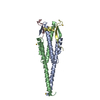
| ||||||||||
|---|---|---|---|---|---|---|---|---|---|---|---|
| 1 |
| ||||||||||
| Unit cell |
| ||||||||||
| Details | The assembly consists of an NSP3 homodimer bound to two fragments of eIF4G. |
- Components
Components
| #1: Protein | Mass: 12842.396 Da / Num. of mol.: 2 / Fragment: C-terminal domain / Mutation: C306S C314S Source method: isolated from a genetically manipulated source Source: (gene. exp.)   Simian rotavirus A/SA11 / Species: Rotavirus A / Production host: Simian rotavirus A/SA11 / Species: Rotavirus A / Production host:   Escherichia coli (E. coli) / References: UniProt: P03536 Escherichia coli (E. coli) / References: UniProt: P03536#2: Protein/peptide |  Eukaryote / eIF4GI Eukaryote / eIF4GIMass: 3203.653 Da / Num. of mol.: 2 / Fragment: residues 132-159 of AAC82471 / Source method: obtained synthetically / Details: sequence appear naturally in Homo sapiens / References: UniProt: Q04637 #3: Chemical | #4: Water | ChemComp-HOH / |  Water Water |
|---|
-Experimental details
-Experiment
| Experiment | Method:  X-RAY DIFFRACTION / Number of used crystals: 1 X-RAY DIFFRACTION / Number of used crystals: 1 |
|---|
- Sample preparation
Sample preparation
| Crystal | Density Matthews: 2.67 Å3/Da / Density % sol: 53.88 % | |||||||||||||||||||||||||
|---|---|---|---|---|---|---|---|---|---|---|---|---|---|---|---|---|---|---|---|---|---|---|---|---|---|---|
Crystal grow | Temperature: 275 K / Method: vapor diffusion, hanging drop Details: PEG-MME 550, glucose, theophylline, unbuffered, VAPOR DIFFUSION, HANGING DROP at 275K | |||||||||||||||||||||||||
| Crystal grow | *PLUS Temperature: 4 ℃ | |||||||||||||||||||||||||
| Components of the solutions | *PLUS
|
-Data collection
| Diffraction | Mean temperature: 93 K |
|---|---|
| Diffraction source | Source:  SYNCHROTRON / Site: SYNCHROTRON / Site:  NSLS NSLS  / Beamline: X9A / Wavelength: 1.0447 Å / Beamline: X9A / Wavelength: 1.0447 Å |
| Detector | Type: MARRESEARCH / Detector: CCD / Date: Aug 1, 2001 |
| Radiation | Monochromator: crystal / Protocol: MAD / Monochromatic (M) / Laue (L): M / Scattering type: x-ray |
| Radiation wavelength | Wavelength : 1.0447 Å / Relative weight: 1 : 1.0447 Å / Relative weight: 1 |
| Reflection | Resolution: 2.38→20 Å / Num. all: 26535 / Num. obs: 24286 / % possible obs: 99.9 % / Observed criterion σ(I): 1 |
| Reflection shell | Resolution: 2.38→2.46 Å / % possible all: 99.9 |
| Reflection | *PLUS Num. obs: 26797 / Num. measured all: 110178 / Rmerge(I) obs: 0.074 |
| Reflection shell | *PLUS % possible obs: 99.9 % / Rmerge(I) obs: 0.316 |
- Processing
Processing
| Software |
| |||||||||||||||||||||||||
|---|---|---|---|---|---|---|---|---|---|---|---|---|---|---|---|---|---|---|---|---|---|---|---|---|---|---|
| Refinement | Method to determine structure : :  MAD / Resolution: 2.38→20 Å / Cross valid method: THROUGHOUT / σ(F): 2 / Stereochemistry target values: Engh & Huber MAD / Resolution: 2.38→20 Å / Cross valid method: THROUGHOUT / σ(F): 2 / Stereochemistry target values: Engh & Huber
| |||||||||||||||||||||||||
| Refinement step | Cycle: LAST / Resolution: 2.38→20 Å
| |||||||||||||||||||||||||
| Refine LS restraints |
| |||||||||||||||||||||||||
| Refinement | *PLUS % reflection Rfree: 7 % | |||||||||||||||||||||||||
| Solvent computation | *PLUS | |||||||||||||||||||||||||
| Displacement parameters | *PLUS | |||||||||||||||||||||||||
| Refine LS restraints | *PLUS Type: c_angle_deg / Dev ideal: 1.01 |
 Movie
Movie Controller
Controller


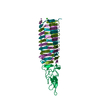
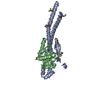
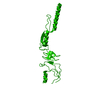



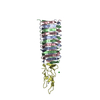

 PDBj
PDBj










